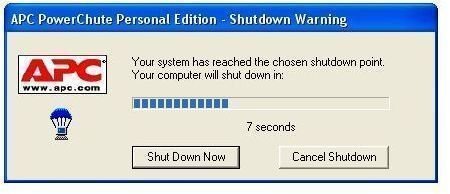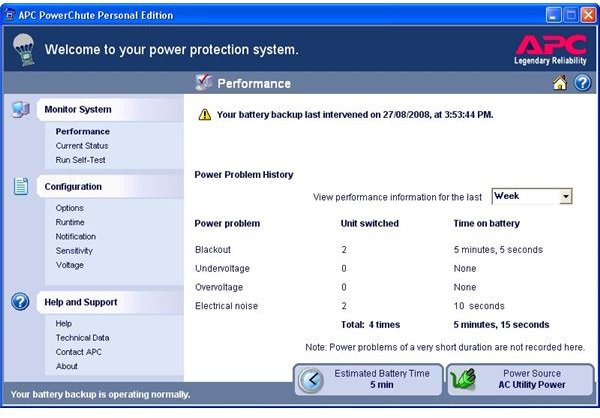APC Back-UPS RS1300 LCD Uninterruptible Power Supply Review - Conclusion
Hot Stuff or Cold Fish?
Before discussing the system’s performance when the power goes out completely, note that it keeps the system running without any fuss (literally: it won’t alarm or notify you on screen even) during those brief drops in power that cause lights to dim for a moment and less well equipped PC’s to crash.
Once installation and configuration was complete (installation, configuration, and product features were discussed in the previous article) the first thing I noticed was that the product is quite warm to the touch. It wasn’t frying an egg warm, but make sure the APC Back-UPS RS 1300 has plenty of room around the fan in the back, and use a large book or some such to keep the vents along the bottom out of shaggy carpet.
APC Back-UPS RS 1300 LCD


Runtime Tests
As far as seeing what happens when the lights go out, all of my tests were run, with a fully charged battery of course, by shutting off power at the circuit box to the outlet into which the RS 1300 is plugged. The first test took place with a load of 241Watts as indicated by the unit itself and the APC PowerChute software. They also reported a run time of 18 minutes on battery. Note that APC’s runtime chart would indicate closer to a half-hour. The alarm sounded as expected and the software informed me from the taskbar that I was now on battery power. Power usage remained constant while I surfed the web and loaded some games. The alarm continued sounding every minute or so in a very annoying fashion.
Of course the power usage reporting from the software is anything but highly accurate and real time: its job is to let you know if you have too much stuff plugged in and to ball-park the remaining run time. The historical reporting of power events is off target as well; the first pic shows the results of my first test and a few previous events, claiming a total time on battery of 5 minutes and 15 seconds. The test ran 21 minutes 43 seconds, so numbers reported by the unit and software should definitely be taken with a grain of salt. The first shut down request (second picture) came after 15:42, when there were actually six minutes of time left. The last warning came at 19:31.
Test two took place with a reported consumption of 273 Watts (the increase due to CPU benchmarking) and runtime of 16 minutes. Note that APC’s website indicates the RS 1300 as having a 23 minute runtime at a 300 Watt load. Shutting off incoming power caused the alarm to sound and on screen notification to appear. This time I turned off the alarm. Playing music, running a scanner, and talking on a VoIP phone got the reported power consumption up to 288 watts. This fed my suspicions about the software’s accuracy as the scanner alone draws a good deal of power. The system ran for 18:07, with warnings after 13:07 and 17:00.
The third test involved turning off the printer and speakers, which resulted in a reported draw of 241 Watts and runtime of 20 minutes. This time the alarm, mercifully, did not go off. I would have liked a setting to have the alarm go off at the beginning of the power event then be quiet, but as we see in the third picture there is no such choice. I will be running silent from now on, and just use any other electrical device in the room to monitor changes in the state of incoming power instead of the incessant alarm. The overall run time was 22:27, with warnings at 17:43 and 20:47.
The RS 1300 Gets the Job Done
I don’t think APC’s runtime chart is misleading: I think the APC Back-UPS RS 1300 LCD and its accompanying software under-report power consumption. The amount of power my PC draws, as reported by the unit and software, seemed low from day one, and the run times from the tests are closer to a 300 to 400 Watt draw according to APC’s charts, which seems more realistic for my PC and everything else I have plugged into the RS 1300. At least in my case, the configuration tools and data on APC’s web-site were consistent with each other and my expectations, just not with the reported power draw.
Though the accuracy of the draw reporting was off, the remaining time and shut down initiations were reported and handled reasonably precisely and conservatively, erring slightly on the side of caution.
Most importantly, the APC Back-UPS RS 1300 LCD keeps your computer up when the grid goes down. The reasonably generous runtime allows you to save your documents, finish your phone call, print the two pages you need, even get your hero to a nice safe place where you can log out, all without scrambling and even if your PC is on the power-hungry side. Those with smaller Wattage requirements will want to look at UPSs that don’t have quite the juice or price as the RS 1300 LCD.
Related Reading
>» The APC Back-UPS RS 1300 LCD Uninterruptible Power Supply Tested and Reviewed - Part 1
>» Is that Old Surge Protector Enough?
>» Feature-Rich Surge Protectors and Uniterruptilbe Power Supplies
